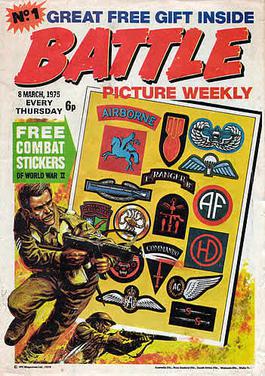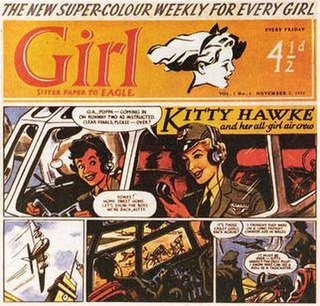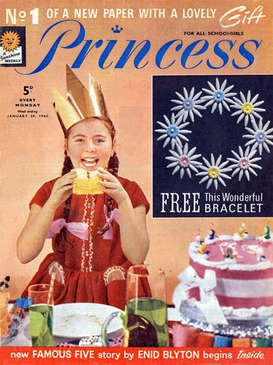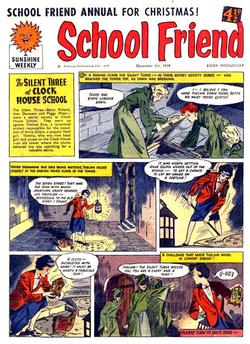
Patrick Eamon Mills is an English comics writer and editor who, along with John Wagner, revitalised British boys' comics in the 1970s, and has remained a leading light in British comics ever since. He has been called "the godfather of British comics".

John Wagner is an American-born British comics writer. Alongside Pat Mills, he helped revitalise British comics in the 1970s, and continues to be active in the British comics industry, occasionally also working in American comics. He is the co-creator, with artist Carlos Ezquerra, of the character Judge Dredd.
Gerry Finley-Day is a Scottish comics writer, prolific from the 1960s to the 1980s, best known as the creator of "Rogue Trooper".

Battle Picture Weekly was a British weekly boys' war comic published by IPC Magazines from 8 March 1975 to 23 January 1988, when it merged with the new incarnation of Eagle after 644 issues. Most stories were set in World War II, with some based on other conflicts, while factual features also focused on warfare.
James George Baikie was a Scottish comics artist best known for his work with Alan Moore on Skizz. He was also a musician.
Malachy Coney is a comics writer and cartoonist from Belfast, Northern Ireland. He grew up in Ardoyne in the north of the city.

Jinty was a weekly British comic for girls published by Fleetway in London from 1974 to 1981, at which point it merged with Tammy. It had previously merged with Lindy and Penny in a similar fashion, illustrating the 'hatch-match-dispatch' process practiced by editorial staff in the London comics publisher.

Misty was a weekly British comic magazine targeted at girls and published by Fleetway in the late 1970s. Focusing on horror stories, it was one of the few British girls' comics that was also popular with boys. Although Misty lasted less than two years it is remembered and admired to this day.
John Armstrong was a British comics artist, best known for his work in Misty and Tammy, for which he drew the long-running strip Bella. Other strips he has drawn include The Secret Gymnast in Bunty.

Girl was the name of two weekly comics magazines for girls in the United Kingdom.

Princess Tina was a British weekly girls' comic anthology published by Fleetway Publications and IPC Magazines from 23 September 1967 to 12 January 1974. The comic was created by combining two underperforming Fleetway titles — Princess and Tina — into a third, new comic. Notable strips included the long-running family drama "The Happy Days" and "Patty's World". The latter would outlive Princess Tina, continuing after the comic was merged into Pink.

Judy was a British pre-teen and teen girl's magazine, primarily in comic book form. Judy was extant from 1960 to 1991. From 1991 to 1997 it was combined with another title in Mandy and Judy magazine. Judy was published by DC Thomson.
Malcolm Campbell Shaw was a British comics writer and editor, involved in many girls' comics such as Jinty, New Mirabelle, and Misty.
British girls' comics flourished in the United Kingdom from the 1950s through the 1970s, before beginning to decline in popularity in the 1980s and 1990s. Publishers known for their girls' comics included DC Thomson and Fleetway/IPC. Most titles appeared weekly, with the content primarily in picture-story format. The majority of the stories were serialized, with two or three pages per issue, over eight to twelve issues. They were marketed toward young teen girls.

Girls' Crystal was a British weekly fictional anthology publication aimed at girls. Published by Amalgamated Press and later Fleetway Publications from 26 October 1935 to 18 May 1963. Uniquely for an Amalgamated Press title, Girls' Crystal began as a story paper before transforming into a picture comic between editions, with the new format debuting on 21 March 1953. It ran for a combined total of 1432 issues before merging with School Friend in 1963.

Princess was a British weekly girls' comic anthology published by Fleetway Publications and, later, IPC Magazines. The first version was published between 30 January 1960 and 16 September 1967, and featured a mix of comic strips, text stories and a large proportion of features; it was merged with Tina to form a new title - Princess Tina - after 399 issues.

June was a British weekly girls' comic anthology published by Fleetway Publications and IPC Magazines from 18 March 1961 to 15 June 1974. Designed as a response to DC Thomson's hit Bunty, June never quite eclipsed its Scottish rival but was nevertheless a success on its own terms, reaching 631 issues before being merged into Tammy in 1974.

The Cat Girl is a British comic character who has appeared in eponymous strips published by IPC Magazines and Rebellion Developments. The character, a girl called Cathy Carter who finds a suit that gives her the attributes of a cat and becomes a crimefighter, first appeared in the launch issue of weekly girls' comic Sally on 14 June 1969.

"End of the Line..." is a British comic strip published by IPC Magazines in the girls' comic anthology title Misty between 12 August and 18 November 1978. Written by Malcolm Shaw with art by John Richardson, the story revolves around Ann Summerton, who begins seeing visions of her dead father while travelling on the London Underground. Like many of the stories featured in Misty, the serial had strong supernatural elements.

School Friend was a British weekly girls' comic anthology published by Amalgamated Press and Fleetway Publications from 20 May 1950 to 23 January 1965. Considered the first British girls' comic and bearing the same name as a popular story paper previously published by Amalgamated Press, School Friend was a huge success and effectively kickstarted the genre in British publishing.














